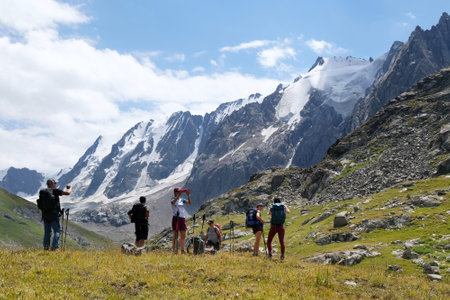Introduction: Setting the Stage for a Safe Hike
There’s something truly American about lacing up your hiking boots, grabbing your backpack, and heading into the wild with friends. From the towering Rockies to the rolling Appalachians, our country’s love affair with outdoor adventure runs deep. But as any seasoned hiker knows, group hikes aren’t just about breathtaking views and memorable snapshots—they’re about preparation, teamwork, and responsibility. Before you set foot on the trail, it’s essential to recognize that safety doesn’t happen by accident. Establishing clear roles and responsibilities within your group isn’t just a best practice; it’s a reflection of the safety-first mindset that defines American outdoor culture. Whether you’re leading a scout troop through a redwood forest or joining friends on a weekend trek along the Pacific Crest Trail, taking time to prepare together sets the stage for an unforgettable—and safe—adventure.
2. Defining Key Roles Within the Group
When venturing into America’s expansive wilderness, assigning clear roles within your hiking group is essential for both safety and enjoyment. Each role—Leader, Navigator, Sweep, and Safety Officer—serves a unique purpose, creating a structure that guides the group through mountain trails, dense forests, or rugged canyons. The following table outlines each key role and its core responsibilities:
| Role | Main Responsibilities | Example Scenario in the American Wilderness |
|---|---|---|
| Leader | Sets pace, makes decisions, keeps morale high. | On a Rocky Mountain trail, the Leader chooses when to take breaks and motivates the group as altitude increases. |
| Navigator | Reads maps, uses GPS or compass, keeps group on route. | In Yosemite National Park, the Navigator checks trail markers and map coordinates to avoid wandering off established paths. |
| Sweep | Stays at the back to ensure no one falls behind or gets lost. | During an Appalachian hike, the Sweep helps a slower hiker over tricky terrain while keeping radio contact with the Leader. |
| Safety Officer | Carries first aid kit, watches for hazards, leads emergency response. | In Zion’s slot canyons, the Safety Officer spots flash flood risks and checks everyone for signs of dehydration or heat exhaustion. |
Assigning these roles before setting out allows every hiker to know their responsibilities and rely on each other’s strengths. For example, if a sudden storm rolls across the Grand Tetons, the group can quickly regroup: the Leader directs shelter setup, the Safety Officer assesses risks from lightning, and the Navigator tracks safe exit routes. This level of organization not only ensures safety but also builds trust—a vital element when exploring America’s wildest landscapes.

3. Clear Communication and Decision-Making Protocols
Effective communication is the backbone of safe group hiking, especially on America’s vast, unpredictable trails. To ensure everyone is on the same page, hikers are encouraged to blend technology with classic group dynamics—an approach that mirrors America’s consensus-driven culture.
Leverage Technology for Safety
Walkie-talkies are a staple in many American hiking groups, offering reliable communication even where cellphone signals fade. Pair these with smartphones for GPS tracking, emergency calls, and group messaging apps, and you have a tech-savvy toolkit that empowers every hiker. Assign someone the role of “communications lead” to manage devices and relay vital information as needed.
Emphasize Group Huddles
At key trail junctions or before tackling tricky terrain, gather everyone together for quick group huddles. This isn’t just about logistics—it’s about fostering a democratic spirit where each voice matters. Encourage everyone to share concerns or ideas; sometimes the quietest hiker spots the biggest hazard.
Consensus-Driven Decisions
Reflecting American values, decisions—such as whether to push forward or turn back—should be made by group consensus whenever possible. A brief vote or open discussion ensures all perspectives are considered, building trust and shared responsibility among the team.
Cultivating Trust Through Openness
By combining walkie-talkies, smartphones, and group discussions, hiking groups create an environment where information flows freely and decisions are respected by all. This proactive approach not only enhances safety but also strengthens camaraderie—a hallmark of memorable American outdoor adventures.
4. Assigning Responsibilities Before Hitting the Trail
Before you step onto the trailhead, it’s essential to thoughtfully assign roles that match each group member’s skills, interests, and comfort levels. This not only makes the hike safer but also ensures everyone feels valued and involved in the adventure. Taking time to talk through responsibilities helps avoid confusion when quick decisions are needed in the wild.
Matching Tasks to Skills and Interests
Start by having an open conversation with your group about past hiking experiences, personal strengths, and what excites each person most. Some might love navigating with a map, while others have a knack for organizing gear or carrying out first aid. By aligning tasks with interests, you empower everyone—whether they’re seasoned hikers or first-timers—to contribute meaningfully.
Sample Task Assignment Table
| Task | Suggested Role | Ideal Skillset/Interest |
|---|---|---|
| Gear Check | Equipment Manager | Detail-oriented, organized, enjoys prepping supplies |
| First Aid Kit & Medical Oversight | Safety Lead | Basic first aid knowledge, calm under pressure |
| Navigation & Map Reading | Navigator | Loves maps/GPS apps, good sense of direction |
| Pace Setting & Group Morale | Pace Setter/Motivator | Encouraging personality, stamina awareness |
| Trail Communications (with rangers/park staff) | Liaison/Communicator | Strong communicator, outgoing, responsible |
| Litter Patrol & Leave No Trace Champion | Sustainability Steward | Passionate about conservation and clean trails |
Empowering Every Member
This approach isn’t just about logistics—it’s about fostering a sense of belonging and accountability within the group. When everyone has a specific responsibility tailored to their abilities or interests, it boosts confidence and ensures that no one feels left out. Even younger hikers or those new to mountain adventures can take on meaningful roles, like spotting trail markers or helping distribute snacks during breaks.
Cultural Tip: American Hiking Traditions
In many U.S. hiking groups, it’s common to rotate certain roles between hikes so everyone gets to build new skills. This tradition not only strengthens teamwork but also keeps the experience fresh—because every trail is a chance for someone new to lead the way.
5. Staying Flexible: Adapting Roles on the Go
One of the most distinctive features of American outdoor culture is adaptability—the ability to pivot quickly in response to changing circumstances. In group hiking, this means that established roles are not set in stone. Trail conditions can shift unexpectedly: a sudden rainstorm might wash out a path, or a steep ascent could be more challenging than anticipated. When these situations arise, the group’s safety depends on everyone’s willingness to adjust responsibilities on the fly.
Imagine you’re navigating a winding trail in the Rockies and your designated navigator starts feeling fatigued. In true American spirit, another team member—perhaps someone with fresh energy or stronger navigation skills—should step up. The same goes for first aid: if your go-to first responder twists an ankle, someone else must take charge, even if it means moving outside their comfort zone.
Emergencies demand rapid adaptation. Whether it’s helping an injured hiker or rerouting due to fallen trees, decisions should be based on real-time needs rather than rigid plans. This flexibility honors the American value of teamwork and resilience; everyone pitches in where they’re needed most. Clear communication is crucial here—make sure everyone knows when roles have changed so that no task falls through the cracks.
Ultimately, safety remains the guiding principle behind every decision. By embracing adaptability and supporting each other through shifting roles, hiking groups can face unforeseen challenges with confidence and unity—turning potential setbacks into memorable moments on the trail.
6. Accountability and Check-Ins During the Hike
On America’s legendary trails—from the misty Blue Ridge to the sun-baked Pacific Crest—the tradition of watching out for each other runs deep. In group hiking, accountability is more than a checklist; it’s an ongoing commitment to safety, camaraderie, and respect for every member of your crew. As you wind through rugged switchbacks or pause on a breezy overlook, establishing a rhythm of regular headcounts, water breaks, and wellness check-ins becomes second nature.
Regular Headcounts: Safety in Numbers
It’s easy to get lost in the awe of panoramic vistas or the silent hush of ancient forests, but keeping track of everyone is crucial. Designate a leader and a sweep—the latter always hiking last—to ensure no one falls behind. Frequent headcounts at trail junctions, rest stops, or after challenging sections help guarantee that every hiker remains accounted for, reinforcing trust within the group.
Water Breaks: Hydration as a Priority
American hiking culture values preparedness, and nothing says “I’ve got your back” like reminding each other to hydrate. Schedule water breaks before signs of fatigue set in. Use these moments not only to replenish but to check gear adjustments and share quick observations about the trail ahead. These shared pauses foster a sense of unity while preventing dehydration and heat-related issues.
Wellness Check-Ins: Looking Out for Each Other
The heart of group hiking lies in mutual care. Regularly ask how everyone’s feeling—physically and mentally—especially after tough climbs or in changing weather. Encourage honesty about blisters, aches, or anxiety; normalizing these conversations creates space for early intervention and support. Checking in with each other honors the American outdoor ethos: we’re only as strong as our most vulnerable hiker.
Embodying Trail Community
By integrating headcounts, water breaks, and wellness check-ins into your hike, you’re doing more than following protocol—you’re weaving yourself into a proud tradition of American trail stewardship. This spirit keeps hikers safe and transforms every trek into a shared adventure where everyone belongs and thrives.
7. Debriefing After the Trek
Just as Americans have long gathered around campfires after a day’s journey to share stories, laughter, and lessons learned, post-hike debriefings are essential for establishing safe group hiking practices. This time-honored tradition translates beautifully into modern hiking culture, where open reflection strengthens bonds and fosters growth within the group.
Why Debrief?
Debriefing after a hike is not just about recounting scenic views or funny mishaps. Its an opportunity to review what went well, identify areas for improvement, and recognize individual and team contributions. This collective reflection ensures that everyone’s voice is heard and valued, reinforcing a sense of belonging and shared responsibility—key tenets in American outdoor communities.
Celebrating Successes
Take time to acknowledge milestones reached, whether it was a challenging summit conquered or seamless teamwork during a tricky section of trail. Celebrating these achievements boosts morale and motivates hikers to continue developing their skills and safety awareness.
Learning from Experience
Encourage everyone to share their perspectives on what could be improved next time—navigation choices, pace setting, or gear selection. Framing feedback positively helps cultivate a culture of continuous learning rather than blame. In true American spirit, focus on solutions and actionable steps for future adventures.
Building Stronger Hiking Communities
Through regular debriefs, groups develop trust, accountability, and camaraderie. These sessions mirror the warmth and openness found in traditional campfire circles, ultimately building safer, more resilient hiking communities across America’s wild landscapes.
By weaving debriefing into your group’s routine, you honor both the legacy of American outdoor storytelling and the ongoing pursuit of safer, more enjoyable adventures together.


